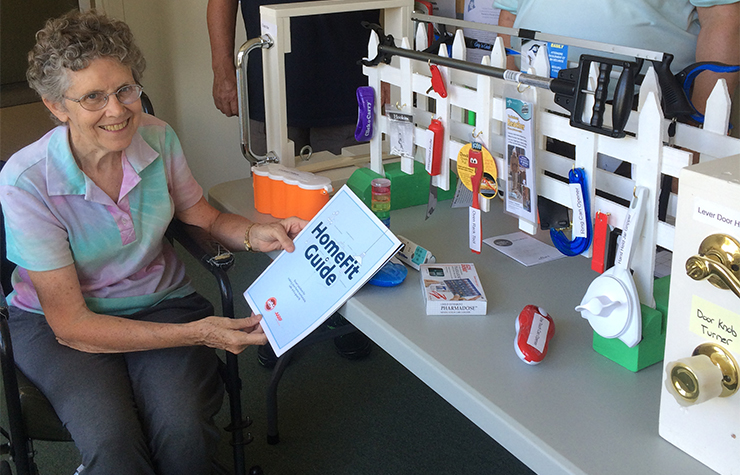
- Select a language for the TTS:
- UK English Female
- UK English Male
- US English Female
- US English Male
- Australian Female
- Australian Male
- Language selected: (auto detect) - EN
Play all audios:
Early in 2015, an older gentleman in Bowdoinham, Maine, asked the town's coordinator of older adult services where he could buy a jar opener similar to the one he remembered his mother
using. Arthritis was making it difficult for him to open jars and cans. Looking for the right opener, he searched department stores, hardware stores, drug stores and cooking shops without
success. Trying to help, the coordinator Googled "jar openers" on her computer, read the information and reviews about several of them and then ordered three styles of jar openers.
After the packages arrived, the man took the openers home to test and report back about which opener worked best for him. Inspired by the inquiry, members of Bowhoindon's Advisory
Committee on Aging (ACOA) — which consists of seven community members appointed by the town's leadership — had started to look for simple devices (medication boxes, no-tie shoelaces,
strobe-light doorbells and smoke detectors) that could be helpful to the town's older residents. Those residents were also asked to identify problems in need of solutions and recommend
products they had found useful. The collective efforts and experiences inspired ACOA to create a "Tool Table" display of gadgets, utensils and hardware that can make everyday life
a little easier. Patricia Oh, Bowdoinham's older adults service coordinator, and Peter Morelli of AARP Maine explain how that was done. AN EDUCATIONAL "TOOL TABLE" DISPLAY
WHERE: Located about 30 miles northeast of Portland, Maine, Bowdoinham (population 2,889) is a rural community where the median age is 41.8 and about 20 percent of the citizenry is 60 or
older. Bowdoinham is a member of the AARP Network of Age-Friendly Communities. WHY AND FOR WHOM: By displaying household, personal care and automobile-specific items that can be especially
helpful for older adults, people can learn about useful tools, try different devices and decide what to buy. THE TIMELINE: The town's "Tool Table" planning began in February
2015, and the collected tools were displayed in June at an open house hosted by the Bowdoinham Public Library and Bowdoinham Historical Society. At the event the tools were displayed on two
8-foot-long conference tables. It became quickly obvious that a more space-efficient display was needed. Four volunteers accepted the design challenge. Before summer's end the chosen
display unit for showcasing the tools took up semipermanent residence at the Bowdoinham Town Office. THE PROCESS STEP 1: IDENTIFYING SUPPORT Bowdoinham's Advisory Committee on Aging
presented the tool table idea to the town's Select Board, which is a group of five elected representatives who serve as a town council. The board's chair, who happens to be a
retired vice president of the disability insurance provider UNUM, arranged for a visit with the company's rehabilitation specialists to brainstorm and gather ideas. UNUM agreed to
provide ongoing technical assistance with the project and connected ACOA with funding sources, which were needed for purchasing tools. STEP 2: IDENTIFYING THE TOOLS Based on conversations
with UNUM as well as with community members, ACOA created a seven-page printed catalog (right) that describes more than 30 tools, lists the prices and where and how to buy each item. Since
many of Bowdoinham's older residents do not use the Internet, prefer to use cash rather than credit cards and/or want to shop locally, ACOA made arrangements with the owner of
Bowdoinham Hardware to keep the catalog in the store and place orders for customers seeking the nonmedical items. STEP 3: DESIGNING THE TOOL TABLE Since ACOA needed to figure out a way to
display the more than 30 tools it had gathered, community volunteers with a background in design and construction were recruited for the task. The display's design needed to be: *
Simple, visually appealing and easy to construct and transport * Heavy-duty enough to allow all of the tools to be displayed * Accessible to people using a wheelchair * Flexible enough to
allow for a changing arrangement of tools or varying sizes * Clearly visible in ambient lighting (so it couldn't include, for instance, shelves that might make it harder for passersby
to see the tools) * Usable without electricity * Suitable for any of the standard-sized tables available today STEP 4: BUILDING THE TOOL TABLE Photo courtesy Advisory Committee on Aging,
Bowdoinham Maine IMAGES 1 THROUGH 5 SHOW THE ELEMENTS OF THE HANDY TOOLS DISPLAY. 1. The display surface chosen for Bowdoinham’s tool table is a 5-foot-long table that is built of a
lightweight composite and has folding legs. 2. The central display consists of two 3-foot -ong by 18-inch-high sections of picket fencing. Each was painted white and fit with 12 to 18 cup
hooks that are used to hang the tools and are arranged according to the size of the tools that will be displayed. (Image 1) 3. A one-foot base to hold the picket fence piece(s) upright was
crafted from a 4 x 4 x 12-inch block of wood. A dado saw was used to make two grooves on the opposite ends of the same side of each block. After cutting and sanding the base piece, it was
painted green. (Images 2 and 3) 4. In addition to the picket fence sections, each end of the table features a square wooden frame that's made with four pieces of 1-inch-thick board that
is approximately 6 inches wide and 18 inches long. The two wooden frames are attached at either end of the table with two ⅜" x 4 ½" stainless steel screw eyebolts and a ⅜"
wing nut. Two holes are drilled through the bottom of the box at approximately three inches from each edge. Aligning holes are drilled into the table. Each eyebolt is placed through the hole
in the box and the aligning holes in the table. The wingnut is tightened from the underside of the table. (Image 4) 5. The length of the base unit (12 inches) allows two sections of fencing
to be installed — each with its cup hook side facing outward. Two single sections of picket fence placed next to one another need two bases for support. Since the bases are able to join two
sections of fencing, four single sections of picket fencing would require three base pieces. (Image 5) STEP 5: THE SUPPLY LIST _FOR BUILDING AND PLACING A SINGLE 3-FOOT-LONG DISPLAY:_ * 1
rectangular table that's large enough to hold the picket fence display and side frames * Two 3' sections of picket fencing * About 30 cup hooks (to be inserted near the top of the
pickets or as needed by the items displayed) * 4" x 4" wood suitable for cutting into two 12" long base pieces. * 1" x 6" wood board suitable for cutting into eight
18" long planks for building two side frames * Four ⅜" x 4½" stainless steel screw eyebolts * Four ⅜" wing nuts * Sandpaper * Paint, stain and/or sealant for the
picket fence sections, base and end displays _FOR STOCKING THE DISPLAY, CONSIDER USING SOME OR ALL OF THESE ITEMS (WHICH YOU CAN LEARN MORE ABOUT BY DOWNLOADING BOWDOINHAM'S "Tools
for Everyday Living" GUIDE). _ * Wireless strobe doorbell * Strobe smoke alarm * Grab bars * Reach tools * A standing assist tool * A one-touch can opener * A ring-style can opener *
Rubber jar grips * Hand-held jar gripper openers * An undercabinet jar opener * A one-touch jar opener * A push-and-pull oven rack tool * A talking clock * LED night lights * LED
motion-sensor lights * A hands-free lighted page magnifier and/or portable magnifier * Small tools (scissors, nail clippers, tweezers, needle-nose pliers, etc.) with built-in magnifiers *
Prism glasses * Pill boxes with locks * Pill boxes with alarms * Pill boxes for people with limited vision * A button aid and zipper hook * Lever-style door handles and D-shaped cabinet
pulls * Key turners * Large-knob light switches * A long-handled shoe horn * Long-handled toe nail clippers * No-tie elastic shoelaces * Weighted writing tools * Wearable anti-fatigue soles
for shoes * Shoes with spring-cushion technology * Carry handles for clipping multiple shopping bags together * A vehicle transfer support handle * A seat belt grabber handle * A seat belt
extender * A car caddie for carrying and holding small items * A swivel seat * An amplified phone (or volume control attachment or ringer amplifier) * Ergonomic gardening tools *
Long-handled tools, such as dusters WHAT GOES WHERE Displaying tools on the picket fence sections keeps the tools organized and allows easy access for reaching and trying the devices even if
a person is a wheelchair user or very short. * ITEMS HUNG FROM THE PICKET FENCE INCLUDE a seat belt extender, a seat belt grabber handle, weighted writing tools, long-handled toe-nail
clippers, a long-handled shoe horn, a key turner, magnifiers, an LED sensor light, a push-and-pull oven rack tool and a standing assist device. * THE WOODEN FRAMES are used to display items
that need to be installed, such as lever-style door handles, a mounted jar opener, grab bar, smoke detector with a strobe light, vehicle transfer support handle and a battery-operated
portable strobe door bell. * THE TABLE SPACE DISPLAYS items that cannot be hung — such as the medication boxes, one-touch can opener, the talking clock, LED night lights, prism glasses,
grabbers and the shoeware. THE COST Counting the materials needed to build the display, the table and the displayed items themselves, the cost comes to about $575. If the building materials
and the table are donated or gathered from scrap, deduct about $125 from the total cost. HOW THE TOOL TABLE IS BEING USED Bowdoinham’s tool table is semipermanently on display in the
Bowdoinham Town Office in an 8-foot x 8-foot space that allows residents to try the devices whenever the town office is open. The display was designed to be portable, and it has traveled to
Bowdoinham’s Annual Aging Well(ness) Fair and Celebrate Bowdoinham. ACOA has also shared the tool table with neighboring communities. THE BENEFITS AND OUTCOMES The Advisory Committee on
Aging's three-year action plan includes objectives for housing services that support aging in place. An aspect of the plan is to make affordable home modification information and
services available. The tool table display is an inexpensive way to educate people about devices that can help them adapt to the physical changes that come with age. In addition to
displaying the tools, the tool table holds copies of the AARP _HomeFit Guide_. Although it wasn't an initial goal of the project, the tool table display in Bowdoinham has attracted
people of all ages — including young mothers looking for a way to do things single-handedly, shoppers buying gifts for relatives, middle-aged people wanting to simplify their lives and older
adults in need of devices to help them adapt to age-related changes. Says Patricia Oh, Bowdoinham's older adults service coordinator: "Everyone, of every age, is happier when they
have the tools to make life easier." _Published October 2015_ More from AARP.org/Livable Use the dropdown to choose a livability topic. Select a Subject







